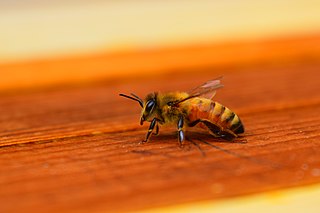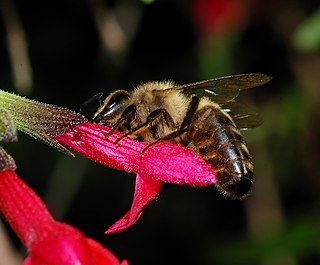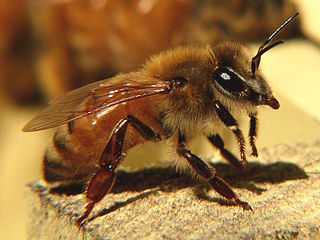
A honey bee is a eusocial flying insect within the genus Apis of the bee clade, all native to mainland Afro-Eurasia. After bees spread naturally throughout Africa and Eurasia, humans became responsible for the current cosmopolitan distribution of honey bees, introducing multiple subspecies into South America, North America, and Australia.

The Africanized bee, also known as the Africanized honey bee (AHB) and colloquially as the "killer bee", is a hybrid of the western honey bee, produced originally by crossbreeding of the East African lowland honey bee (A. m. scutellata) with various European honey bee subspecies such as the Italian honey bee (A. m. ligustica) and the Iberian honey bee (A. m. iberiensis).
Within biological taxonomy, a honey bee race would be an informal rank in the taxonomic hierarchy, below the level of subspecies. It has been used as a higher rank than strain, with several strains making up one race. Therefore, a strain is a lower-level taxonomic rank used at the intraspecific level within a race of a subspecies. Strains are often seen as inherently artificial concepts, more usually within biology as characterized by a specific intent for genetic isolation, however, within beekeeping circles, strain is more likely to be used to describe very minor differences throughout the same subspecies, such as the color ranges of A. m. carnica from brown to grey. Within A. m. ligustica there are two races, the darker leather brown northern Italian bee from the Ligurian Alps region which was discovered to be resistant to acarine in the 1900s, while the other Italian bee race, from regions near Bologna and further south, was highly susceptible to acarine and within this race there are two color strains, the traditional Italian yellow and a rarer all-golden color.

The Apis mellifera mellifera is a subspecies of the western honey bee, evolving in central Asia, with a proposed origin of the Tien Shan Mountains and later migrating into eastern and then northern Europe after the last ice age from 9,000BC onwards. Its original range included the southern Urals in Russia and stretched through northern Europe and down to the Pyrenees. They are one of the two members of the 'M' lineage of Apis mellifera, the other being in western China. Traditionally they were called the Black German Bee, although they are now considered endangered in Germany. However today they are more likely to be called after the geographic / political region in which they live such as the British Black Bee, the Native Irish Honey Bee, the Cornish Black Bee and the Nordic Brown Bee, even though they are all the same subspecies, with the word "native" often inserted by local beekeepers, even in places where the bee is an introduced foreign species. It was domesticated in Europe and hives were brought to North America in the colonial era in 1622 where they were referred to as the English Fly by the Native Americans.

The Carniolan honey bee is a subspecies of the western honey bee. The Carniolan honey bee is native to Slovenia, southern Austria, and parts of Albania, Croatia, Bosnia and Herzegovina, Montenegro, Serbia, Hungary, Romania, Bulgaria and North-East Italy.

Apis mellifera ligustica is the Italian bee or the Italian Honey bee which is a subspecies of the western honey bee.
Nosema apis is a microsporidian, a small, unicellular parasite recently reclassified as a fungus that mainly affects honey bees. It causes nosemosis, also called nosema, which is the most common and widespread of adult honey bee diseases. The dormant stage of N. apis is a long-lived spore which is resistant to temperature extremes and dehydration, and cannot be killed by freezing the contaminated comb. Nosemosis is a listed disease with the Office International des Epizooties (OIE).

The Cape honey bee or Cape bee is a southern South African subspecies of the western honey bee. They play a major role in South African agriculture and the economy of the Western Cape by pollinating crops and producing honey in the Western Cape region of South Africa. The species is endemic to the Western Cape region of South Africa on the coastal side of the Cape Fold mountain range.
The Maltese honey bee, Apis mellifera ruttneri, is a subspecies of the western honey bee, endemic to the Maltese islands which are situated in the Mediterranean Sea.

The East African lowland honey bee is a subspecies of the western honey bee. It is native to central, southern and eastern Africa, though at the southern extreme it is replaced by the Cape honey bee. This subspecies has been determined to constitute one part of the ancestry of the Africanized bees spreading through North and South America.

The Macedonian bee is a subspecies of the western honey bee. It is found mainly in Albania, Bulgaria, North Macedonia, Northern Greece and other places in the Balkans as well. Originally this subspecies was described based on morphological characteristics by Friedrich Ruttner, as were the adami, cecropia and cypria subspecies.

The western honey bee or European honey bee is the most common of the 7–12 species of honey bees worldwide. The genus name Apis is Latin for 'bee', and mellifera is the Latin for 'honey-bearing' or 'honey-carrying', referring to the species' production of honey.

Apis cerana indica, the Indian honey bee, is a subspecies of Asiatic honey bee. It is one of the predominant bees found and domesticated in India, Pakistan, Nepal, Myanmar, Bangladesh, Sri Lanka, Thailand and mainland Asia. Relatively non-aggressive and rarely exhibiting swarming behavior, it is ideal for beekeeping.
Apis mellifera iberiensis, or the Spanish bee, is a western honey bee subspecies native to the Iberian Peninsula. It is also found on the Balearic Islands.

Apis cerana, the eastern honey bee, Asiatic honey bee or Asian honey bee, is a species of honey bee native to South, Southeast and East Asia. This species is the sister species of Apis koschevnikovi and both are in the same subgenus as the western (European) honey bee, Apis mellifera. A. cerana is known to live sympatrically along with Apis koschevnikovi within the same geographic location. Apis cerana colonies are known for building nests consisting of multiple combs in cavities containing a small entrance, presumably for defense against invasion by individuals of another nest. The diet of this honey bee species consists mostly of pollen and nectar, or honey. Moreover, Apis cerana is known for its highly social behavior, reflective of its classification as a type of honey bee.
Apis mellifera cypria(Cyprus honey bee) is a subspecies of the Western honey bee. Its habitat is the Mediterranean island of Cyprus.
Apis mellifera adami is a western honey bee subspecies, endemic to the island of Crete in the eastern Mediterranean.
Apis mellifera adansonii(Western African bee) is a subspecies of the Western honey bee with probably the largest range of Apis mellifera in Africa, belonging to the A (Africa) Lineage of honey bees. Originally identified by Michael Adansonin in his Histoire naturelle du Seneegal in 1757. Initially the name adsansonii was misapplied to A. m. scutelleta and in particular to the Africanised bees of South America.
Apis mellifera artemisia is the Russian steppe honey bee, first identified in 1999 near Kyiv, Ukraine, by only one specimen, but by 2011 its taxonomic status had been called into question, although to date no DNA analysis has been conducted: At the same time the taxonomic status of the Apis mellifera ruttneri on Malta was also called into question, however in 2017 it was confirmed that Apis mellifera ruttneri was a new and separate subspecies.











